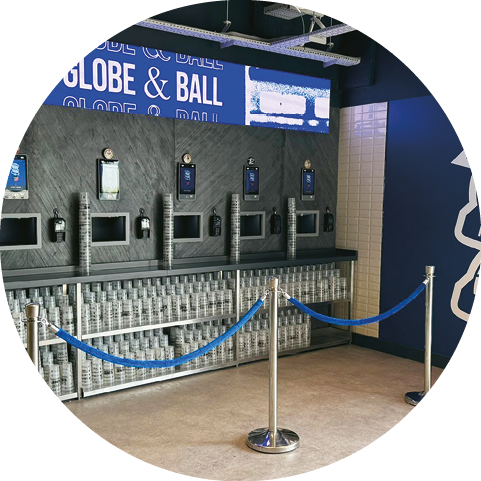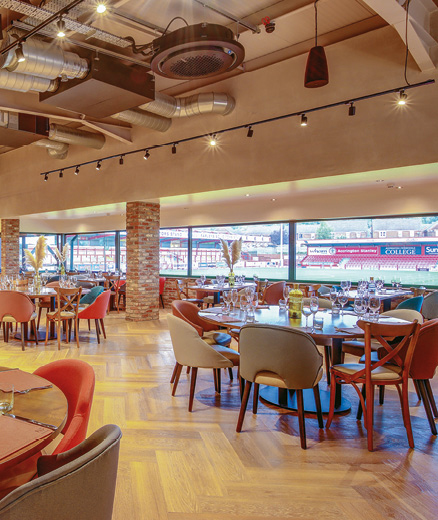SPECIFICATIONS OF FINISHES
When designing or renovating a stadium hospitality area, the finishes used throughout the space can greatly impact the guest experience. Finishes should not only be aesthetically pleasing but also durable, safe and practical.
 Longevity: flooring, seating, and countertops must be able to withstand frequent use without showing signs of wear. Choosing materials known for their longevity reduces the need for constant repairs or replacements, saving time and money in the long term.
Longevity: flooring, seating, and countertops must be able to withstand frequent use without showing signs of wear. Choosing materials known for their longevity reduces the need for constant repairs or replacements, saving time and money in the long term.- Safety: finishes such as slip-resistant flooring and fire-resistant materials should be prioritised to minimise risks. Additionally, when planning for safety, consider the flow of people and make sure the design avoids sharp edges or hazardous layouts that could lead to accidents.
- Comfort: chairs should be comfortable for extended periods, particularly in VIP or dining areas. Cushioned seating, armrests and thoughtful ergonomics can contribute to a more relaxed and enjoyable experience.
- Practicality: stadiums are fast-paced environments, and finishes must be practical for both guests and staff. Surfaces that are easy to clean and maintain will save time during turnover periods, especially between events. For example, choosing stain-resistant fabrics or using wipeable surfaces in high-traffic areas results in spaces that can be quickly refreshed when needed.
- Aesthetic: a visually striking stadium hospitality area can elevate the guest experience and strengthen your brand identity. Consider how the finishes you choose reflect the overall design theme and atmosphere you wish to create. Whether you’re aiming for a sleek, modern look or a warm, inviting feel, the materials, colours and textures you select will play a big role in shaping that environment.
UNDERSTANDING THE TARGET DEMOGRAPHIC
Ultimately, all the decisions you make when planning a stadium fit-out must be based on the needs and expectations of your target audience. Different types of guests will have different requirements, so it’s important to tailor your hospitality areas to suit their preferences.
 Some guests may be looking for a luxurious experience in private suites, while others may prefer a more casual atmosphere in a bar or restaurant setting. A well-designed stadium will offer a variety of hospitality options without creating conflict between spaces. The layout, pricing, and offerings in each area should be distinct enough to cater to different ticket levels while maintaining an overall sense of cohesion.
Some guests may be looking for a luxurious experience in private suites, while others may prefer a more casual atmosphere in a bar or restaurant setting. A well-designed stadium will offer a variety of hospitality options without creating conflict between spaces. The layout, pricing, and offerings in each area should be distinct enough to cater to different ticket levels while maintaining an overall sense of cohesion.
Stadium hospitality is about more than just providing food and drink; it’s about creating an experience that complements the event and leaves a lasting impression. By focusing on operational efficiency, incorporating modern technology and tailoring the design to meet the needs of the audience, stadium spaces can provide guests with a seamless, memorable experience.
A stadium fit-out provider can take the complexity out of renovating and expanding hospitality areas by offering tailored solutions for each aspect of the project. From optimising operational design to integrating the latest technology, they work closely with stadium owners to create spaces that boost guest experience and streamline service.
Whether it’s designing kitchens that support high-volume service, planning bar layouts that reduce crowding, or choosing durable, stylish finishes, a specialist provider will guide every stage of the fit-out. Their expertise in space planning and guest flow management helps owners achieve a practical, comfortable and visually striking hospitality environment that meets the demands of diverse audiences.




